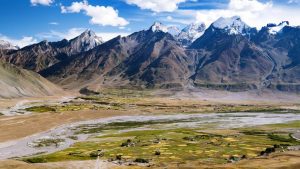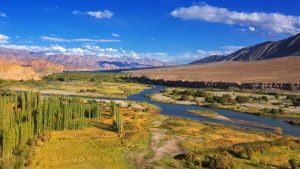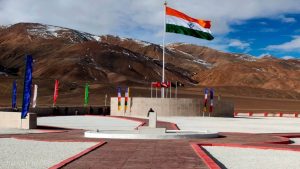About Monasteries in Ladakh
The monasteries in Ladakh complement the beauty of its rugged landscape, and are the centre points around which the spiritual and religious life of its Buddhist population revolves. There are many things that go into making the Ladakh monasteries famous, including architecture, legend and location. Some rest precariously on rocks beside unimaginably deep cliffs, while others are overlooked by craggy peaks and barren mountains, for which Ladakh is famous. Visiting the famous monasteries of Ladakh is not something that you should miss out on during your trip to Ladakh, as it’s one of the best ways of gaining an insight into its rich history and heritage.
Most Famous Monasteries of Ladakh
Best Selling Ladakh Tour Packages
Thiksey Monastery
Thiksey Monastery is famous for its stark resemblance to the Potala Palace in Tibet. Located close to Leh, it is the largest gompa in central Ladakh and a must visit tourist attraction. Among the many attractions of the Thiksey Monastery, one is the Maitreya Temple, which was installed to commemorate the visit of the 14th Dalai Lama in 1970. The other attraction is a 15 meter tall statue of Maitreya Buddha, famous as the largest statue in Ladakh.
Karsha Monastery
Not only is the Karsha Monastery the largest monastery in Zanskar, it also dates back to the 10th century and contains several ancient rock carvings. The monastery belongs to the Gelugpa sect of Buddhism, known by their large Yellow Hats. It also houses the bone relics of Dorje Rinchen. Other attractions of the Karsha Monastery are wall paintings and the Avalokiteshvara Temple.
Hemis Monastery
Hemis Monastery, located around 45 kilometers from Leh, the capital city of Ladakh, is famously known as the richest monastery in Ladakh. It attracts tourists in large numbers during the Hemis Festival, celebrated over the course of two days. A major highlight of the festival is the unfurling of the giant thangka (religious painting). There is also a museum within the monastery which houses a rich collection of Tibetan books, Thangkas, Stupas and gold statues embedded with weapons, precious stones, stuffed vulture pup and carriers.
Alchi Monastery
Alchi Monastery is a monastic complex located in the Alchi Village in the district of Leh. The monastery complex has four separate settlements which house monuments that date back to different times. The paintings which are found inside the Alchi Monastery are the oldest surviving paintings in Ladakh/ A special feature about the wall paintings are the intricate details of both Buddhist & Kashmiri styles of architecture. Other attractions of the Alchi Monastery are the Assembly Hall, Sumtseg, Manjushri Temple and Chortens.
Architecture of Monasteries in Ladakh
The monasteries in Ladakh are enormous in size, and naturally so, since they serve as the accommodation and school for monks, and are home to a library, kitchen and attached fields.
The main building of a monastery is rectangular in shape, and consists of a series of inner halls, open courtyards and passages. In some of the large monasteries like Thiksey and Chemrey Monasteries, the worshipping areas are located on the top stories, like the assembly hall, head lama’s quarter, lhakhangs dedicated to a particular deity. In other monasteries though, like Alchi, separate buildings are alloted to worship.
The shrine rooms contain large statues of Gautam Buddha, Bodhisattvas and Taras, along with kalachakra or the Buddhist wheel of life, icons representing reincarnated lamas in wall recesses, rows of prayer wheels, mandalas, stones carved with prayers, thangkas and manis.
Festivals in Monasteries of Ladakh
The monasteries in Ladakh also serve as the venue for several festivals, and draw large crowds on these special occasions. Some of the famous festivals in Ladakh held in the monasteries are:
- Hemis Tsechu in July (Hemis Monastery)
- Yuru Kabgyat in July (Lamayuru Monastery)
- Thiksey Gustor: different months for each monastery (Thiksey, Spituk & Karsha Monasteries)
- Matho Nagrang in March (Matho Monastery)
- Stok Guru Tsechu in February to March (Stok & Spituk Monasteries)
- Tak Tok Festival in July (Tak Tok Gompa)
- Dosmoche Festival in February (Leh, Likir & Diskit Monasteries)
- Phyang Tsedup in July to August (Phyang Monastery)
Frequently Asked Questions
Q. What is the best time to visit the monasteries in Ladakh?
The best time depends on what you want to experience, what it is that you are after. If you want to attend one of the festivals held in the monasteries, plan your trip accordingly. June to September is the best time to visit Ladakh.
Q. Are there any entry fees for visiting the monasteries in Ladakh?
Some monasteries charge an entry fee if you visit it during one of their festivals.
Q. Do you need any special permits to visit the monasteries in Leh?
No, you do not need any special permits to visit the monasteries in Leh.
Q. Which is the largest and the oldest monastery in Ladakh?
Diskit Monastery is the largest monastery in Ladakh while Lamayuru Monastery is the oldest monastery in Ladakh.

 +91-9212553109
+91-9212553109 Plan Your trip
Plan Your trip












































